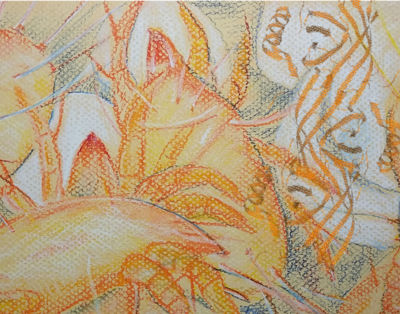Art:Crystallography from the guts of a cockroach
From Proteopedia
Behind the Artwork and the Protein Structure
This image shows Tyrophagus mites that were found feeding on (mammalian) milk powder, having contaminated a milk powder processing plant in New Zealand. The artist who created this image is John Clark, a retired entomologist from New Zealand, from Ara Institute of Canterbury who specialises mites. He has overlaid the PDB entry 5epq on a milk powder grain, with Tyrophagus mites.
View in 3D or go to PDB structure 5epq [1]
In Vivo Crystals
Before obtaining a crystal structure, one must first obtain a crystal, which is not always an easy process. Once in awhile nature saves the scientist potentially decades of work and protein crystals occur in vivo. One such naturally occurring protein crystal is featured in our 2017 calendar for May. It’s found in the strangest of places: the guts of embryonic cockroaches!
All cockroaches lay eggs. Some species deposit them on a surface and leave them, while others carry them within a brood sack. In each case, the developing cockroach survives on the internal food stores within the egg. But Diploptera punctata is different; the mother cockroach retains the eggs in a brood sack but they have very little yolk. Instead, the mother secretes a fluid which the babies eat. This fluid is referred to as ‘milk’ due to its obvious functional similarity with the real, mammalian substance. The protein within this fluid crystallises in the digestive tract of the baby cockroaches, presumably as an effective, concentrated food store. The crystals, in equilibrium with protein in solution, will dissolve as the bug metablises their nutrients.
Lilli-Mip Protein
Solving the structure of this protein, called Lilli-Mip, was not straightforward. Extracting the crystals from the guts of cockroach nymphs can hardly be a pleasant job! In addition to this, on a molecular level, there are several different sequences to the protein, so the crystals were heterogenous. Nevertheless, the structure was solved and published last year in IUCrJ.
The structure showed that Lilli-Mip has a lipocalin fold. Lipocalins are a class of proteins which transport hydrophobic molecules such as lipids. They all have a beta barrel structure made up of 8 beta strands and bind lipids within a central cavity. This lipid binding was also a complication to solving the structure as several different lipids were found to be bound within the Lilli-Mip barrel. These were mainly linoleic and oleic acid - lipids known to be vital for insect development. Lilli-Mip is also glycosylated, so the protein crystals contain not only protein and lipid, but carbohydrate too. When the paper describing Lilli-Mip was published, the media described it as the “superfood of the future”!
The scientists working on this protein estimate the calorific value of a Lill-Mip crystal is, weight-for-weight, around three times that of mammalian milk, but it’s unlikely that dairy farmers will be trading in their cows for six-legged beasts any time soon. It does however highlight that milk (of whatever origin) is a very good nutrient source and as such, storing it can be a challenge. Spoilage of foodstuffs not only causes considerable economic loss, but can lead to health problems. Most obviously, illness caused by the contamination (eg campylobacter in chicken or ergotism from infected wheat), but also food infested with mites or insects can trigger allergic reactions, some severe, in individuals susceptible.
So, while you might not think you have much in common with our insect cousins, but in fact when it comes to mothers nurturing and feeding their developing offspring, we have a surprising amount common with this species of humble cockroach!
Explore the scientific publication
- ↑ Banerjee S, Coussens NP, Gallat FX, Sathyanarayanan N, Srikanth J, Yagi KJ, Gray JS, Tobe SS, Stay B, Chavas LM, Ramaswamy S. Structure of a heterogeneous, glycosylated, lipid-bound, in vivo-grown protein crystal at atomic resolution from the viviparous cockroach Diploptera punctata. IUCrJ. 2016 Jun 27;3(Pt 4):282-93. doi: 10.1107/S2052252516008903. eCollection, 2016 Jul 1. PMID:27437115 doi:http://dx.doi.org/10.1107/S2052252516008903

